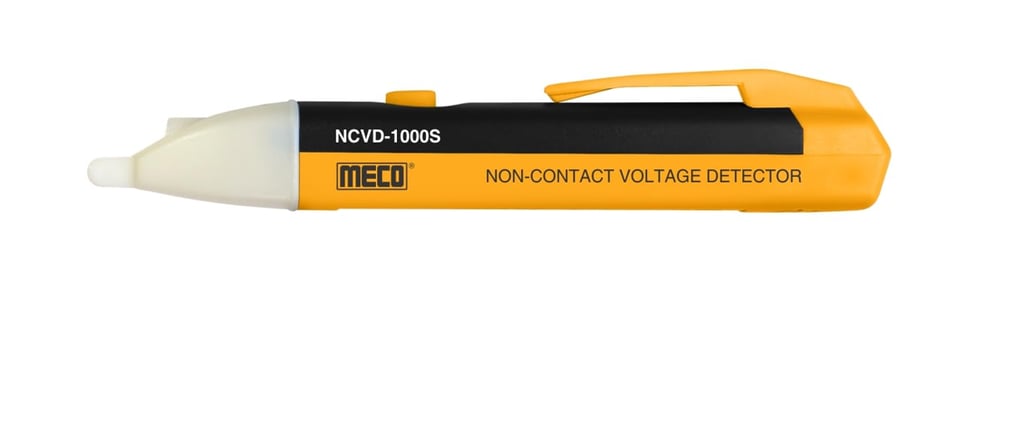NCV Detector Explained: How Non-Contact Voltage Detection Works
Learn how an NCV (Non-Contact Voltage) Detector works to safely identify live wires without touching them — a must-have tool for every electrician!


NCV (Non-Contact Voltage) Detector- Working Explained:
Introduction: In electrical maintenance and troubleshooting, safety always comes first. One of the most useful tools for electricians and technicians is the NCV (Non-Contact Voltage) Detector, also called a Voltage Tester Pen. It helps to identify live wires without touching them, reducing the risk of electric shock.
(Hindi- Electrical maintenance और troubleshooting में safety हमेशा सबसे पहले आती है। Electricians और technicians के लिए सबसे उपयोगी tools में से एक है NCV (Non-Contact Voltage) Detector, जिसे Voltage Tester Pen भी कहा जाता है। यह बिना छुए live wires को पहचानने में मदद करता है और electric shock का खतरा कम करता है)
What is an NCV Detector?
An NCV detector is a pen-shaped device used to detect the presence of voltage in a wire or electrical component without direct contact. Just by bringing the tip of the detector close to the wire or outlet, it indicates whether the wire is live or not.
(Hindi- NCV detector एक pen-shaped device है, जिसका उपयोग wire या electrical component में voltage की presence detect करने के लिए किया जाता है, वह भी बिना direct contact के। केवल detector की tip को wire या outlet के पास लाने से ही यह बता देता है कि wire live है या नहीं)
How Does NCV Detector Work?
The NCV detector works on the principle of electric field detection. When an AC voltage is present in a conductor, it produces an alternating electric field around it.
The NCV detector has a capacitive sensor inside, which senses this electric field.
The built-in circuit then converts this signal into a light or sound indication (usually an LED light or buzzer- For more clarity you can see video on our YouTube Channel). 👉 This means the detector does not need to touch the wire or break the insulation to check voltage.
(Hindi- NCV detector का काम electric field detection principle पर आधारित है।जब किसी conductor में AC voltage होता है, तो उसके चारों ओर एक alternating electric field बनती है। NCV detector के अंदर एक capacitive sensor होता है, जो इस electric field को sense करता है। इसके अंदर का circuit इस signal को light या sound indication (जैसे LED light या buzzer) में बदल देता है। 👉 इसका मतलब है कि detector को wire को छूने या insulation हटाने की जरूरत नहीं होती)
Does NCV Detector Work on AC or DC? (NCV Detector AC पर काम करता है या DC पर?)
✅ AC Voltage: Yes, NCV detectors are designed to detect AC voltage because alternating current produces an alternating electric field which the sensor can pick up.
❌ DC Voltage: NCV detectors generally do not work on DC because direct current does not produce a changing electric field strong enough for detection.
So, NCV detectors are mainly used for AC mains supply (110V/220V/440V) detection.
(Hindi- AC Voltage: हाँ, NCV detectors को AC voltage detect करने के लिए design किया गया है क्योंकि alternating current एक alternating electric field पैदा करता है जिसे sensor आसानी से पकड़ लेता है।
❌ DC Voltage: NCV detectors आमतौर पर DC पर काम नहीं करते, क्योंकि direct current कोई changing electric field पैदा नहीं करता।
इसलिए, NCV detectors मुख्य रूप से AC mains supply (110V/220V/440V) detect करने के लिए उपयोग किए जाते हैं)
Advantages of Using NCV Detector (NCV Detector के फायदे)
Contactless testing – No need to touch bare wires.
Safe to use – Reduces the risk of electric shock.
Quick troubleshooting – Easily identify live wires, faulty switches, or power points.
Compact and portable – Easy to carry in your toolkit.
(Hindi- Contactless testing – Bare wires को छूने की जरूरत नहीं।
Safe to use – Electric shock का खतरा कम करता है।
Quick troubleshooting – Live wires, faulty switches या power points को आसानी से पहचान सकते हैं।
Compact and portable – आसानी से toolkit में carry किया जा सकता है)
Limitations of NCV Detector(NCV Detector की सीमाएँ)
Cannot measure exact voltage, only presence or absence.
May not detect voltage in shielded or very low voltage wires.
Not useful for DC voltage detection.
(Hindi- Exact voltage measure नहीं कर सकता, केवल presence या absence दिखाता है।
Shielded या बहुत low voltage wires में voltage detect नहीं कर पाता।
DC voltage detection के लिए उपयोगी नहीं है)
Conclusion (निष्कर्ष)
An NCV Detector is an essential safety tool for every electrician and electrical enthusiast. It provides a quick and safe way to check live wires, outlets, and circuits. Always remember, it works effectively on AC supply, not on DC circuits.
If you want to see practical testing and demonstration of NCV detector, check out our video and subscribe to our YouTube channel Electrical Knowledge.
Practical Applications and Usage Tips for NCV Detectors:
NCV detectors are not just limited to identifying live wires—they play a vital role in day-to-day electrical inspections. For example, before opening a switchboard or junction box, electricians can quickly scan for live voltage to ensure safety. These detectors are also useful in identifying broken wires inside walls, checking extension cords, and verifying power in sockets. Some advanced models come with adjustable sensitivity, allowing users to detect voltage in tightly packed cables or low-voltage circuits. When using an NCV detector, always ensure the battery is charged and the tip is clean for accurate detection. It’s also recommended to test the detector on a known live source before use to confirm it’s functioning properly. While NCV detectors are highly reliable for preliminary checks, they should be complemented with multimeters or other tools for detailed diagnostics.. Whether you're a professional electrician or a DIY enthusiast, understanding how and when to use an NCV detector can significantly improve safety and efficiency in electrical work.
👉 Visit our YouTube channel to see the practical video. @Electrical Knowledge
NCV Detector हर electrician और electrical enthusiast के लिए एक जरूरी safety tool है। यह live wires, outlets और circuits को जल्दी और सुरक्षित तरीके से check करने में मदद करता है। हमेशा याद रखें, यह केवल AC supply पर सही तरीके से काम करता है, DC circuits पर नहीं।
